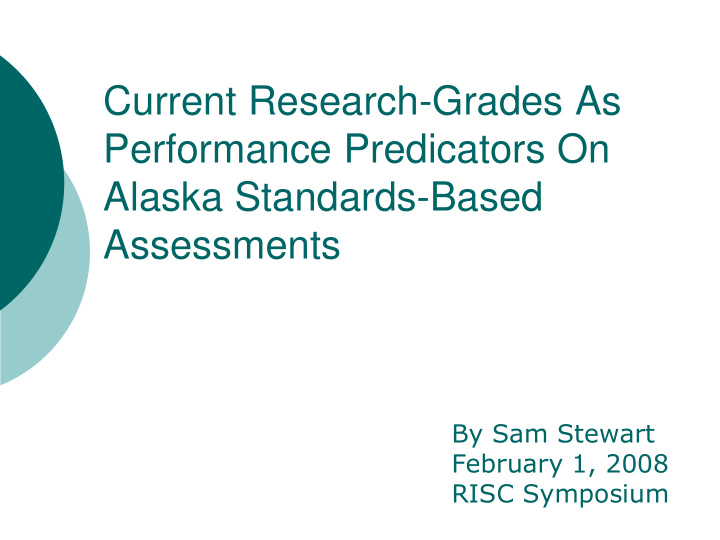



Current Research-Grades As Performance Predicators On Alaska Standards-Based Assessments By Sam Stewart February 1, 2008 RISC Symposium
Statement of the Problem Grades are not an accurate indicator of how students are achieving.
Research Design 1.Quantitative and Comparative A.correlation analysis between grades and test scores B.bivariate tabular analysis to examine relationship between proficiency and receiving C or better
Research Design 2. Qualitative and Descriptive A. survey to determine what factors into teacher grading decisions and the weight given to the factors
Three Types of Grading Criteria 1.Process 2.Product 3.Progress
Process grading criteria: Grading “criteria that relate not to final results, but to how students got there” (Guskey, 2001). According to Guskey (2001), process grading criteria include factors such as “daily work, regular classroom quizzes, homework, class participation, punctuality of assignments, or attendance.”
Product grading criteria: According to Guskey (2001), product criteria relate to students’ specific achievements or levels of performance. They describe what students know and are able to do at a particular point in time. . . . Teachers using product criteria base students’ grades or reports exclusively on final examination scores; final products, such as reports, projects, or portfolios; overall assessments of performance; and other culminating demonstrations of learning.
Progress grading criteria: Criteria that relate to how much students have gained from their learning experiences. This type of grading is also referred to as value- added grading and improvement grading. This type of grading is highly individualized, and a grade’s meaning is not consistent from student to student (Guskey, 2001).
Correlation of Grades by Subject With Standardized Test Subject Grades to standardized test Rubric to standardized test Mathematics .44 .71 Language Arts .58 .70 Note. From “Teacher Judgment in Student Evaluation: A Comparison of Grading Methods,” By D. Wright and M. J. Wiese, 1988, Journal of Education Research, 82(1), pp. 10-14.
Summary of Review of Literature Grading serves several purposes other than 1. reporting student achievement. The history of grading reveals that grading has 2. evolved from teachers giving feedback in narrative form to primarily the use of letter grades in fourth grade and above. The concern over grade inflation indicates that 3. grades may not accurately reflect student achievement. Nonachievement factors are prevalent in teacher 4. grading decisions. Grades are not essential to the learning process. 5.
Seventh Grade Language Arts 1000 Scaled Score 800 600 400 0.00 1.00 2.00 3.00 4.00 Language Arts Grade
Seventh Grade Language Arts: Proficiency Level and Grade Level Relationship Grade 7 Language Arts group Below C C or above Count Row % Col % Count Row % Col % Proficient 78 17.3 69.6 372 82.7 88.4 Not proficient 34 41 30.4 49 59 11.6
Ninth Grade Language Arts 1200 1000 Scaled Score 800 600 400 200 0.00 1.00 2.00 3.00 4.00 Language Arts Grade
Ninth Grade Language Arts: Proficiency Level and Grade Level Relationship Grade 9 Language Arts group Below C C or above Count Row % Col % Count Row % Col % Proficient 103 20 65.6 411 80 89.3 Not proficient 54 52.4 34.4 49 47.6 10.7
Seventh Grade Mathematics Grades 600 500 Scaled Score 400 300 200 100 0.00 1.00 2.00 3.00 4.00 Mathematics Grade
Seventh Grade Mathematics: Proficiency Level and Grade Level Relationship Below C Grade 7 math group C or above Count Row % Col % Count Row % Col % Proficient 36 9.4 40.9 346 90.6 77.9 Not proficient 52 34.7 59.1 98 65.3 22.1
Ninth Grade Algebra 1 600 500 Scaled Score 400 300 200 100 0.00 1.00 2.00 3.00 4.00 Algebra Grade
Ninth Grade Algebra 1: Proficiency Level and Grade Level Relationship Grade 9 Algebra 1 group Below C C or above Count Row % Col % Count Row % Col % Proficient 29 20.9 72.5 110 79.1 84 Not proficient 11 34.4 27.5 21 65.6 16
Teacher Grading Practices and Weight Given to Grading Criteria
Teacher Responses Regarding What Grades Should Reflect Grading criteria Teacher # % of teachers Student achievement 6 17 % Student effort 0 0 % Student growth 1 3 % All of the above 25 71 % Other 0 0 % Student achievement and effort 3 9 %
Grading Practices: Overall % of final grade Grading practices # teachers Min. Max. Mean SD (%) Product 34 0 75 45 21 Process 34 25 100 54 21 Growth 32 0 14 1 3
Conclusion Grades and teacher grading practices in traditional schools do not accurately reflect student achievement and what students can do.
Questions
Recommend
More recommend